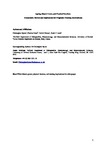Ageing, Muscle Power and Physical Function: A Systematic Review and Implications for Pragmatic Training Interventions
| dc.contributor.author | Byrne, Chris | |
| dc.contributor.author | Faure, C | |
| dc.contributor.author | Keene, DJ | |
| dc.contributor.author | Lamb, SE | |
| dc.date.accessioned | 2018-09-03T10:19:08Z | |
| dc.date.available | 2018-09-03T10:19:08Z | |
| dc.date.issued | 2016-09 | |
| dc.identifier.issn | 0112-1642 | |
| dc.identifier.issn | 1179-2035 | |
| dc.identifier.uri | http://hdl.handle.net/10026.1/12217 | |
| dc.description.abstract |
BACKGROUND: The physiological impairments most strongly associated with functional performance in older people are logically the most efficient therapeutic targets for exercise training interventions aimed at improving function and maintaining independence in later life. OBJECTIVES: The objectives of this review were to (1) systematically review the relationship between muscle power and functional performance in older people; (2) systematically review the effect of power training (PT) interventions on functional performance in older people; and (3) identify components of successful PT interventions relevant to pragmatic trials by scoping the literature. METHODS: Our approach involved three stages. First, we systematically reviewed evidence on the relationship between muscle power, muscle strength and functional performance and, second, we systematically reviewed PT intervention studies that included both muscle power and at least one index of functional performance as outcome measures. Finally, taking a strong pragmatic perspective, we conducted a scoping review of the PT evidence to identify the successful components of training interventions needed to provide a minimally effective training dose to improve physical function. RESULTS: Evidence from 44 studies revealed a positive association between muscle power and indices of physical function, and that muscle power is a marginally superior predictor of functional performance than muscle strength. Nine studies revealed maximal angular velocity of movement, an important component of muscle power, to be positively associated with functional performance and a better predictor of functional performance than muscle strength. We identified 31 PT studies, characterised by small sample sizes and incomplete reporting of interventions, resulting in less than one-in-five studies judged as having a low risk of bias. Thirteen studies compared traditional resistance training with PT, with ten studies reporting the superiority of PT for either muscle power or functional performance. Further studies demonstrated the efficacy of various methods of resistance and functional task PT on muscle power and functional performance, including low-load PT and low-volume interventions. CONCLUSIONS: Maximal intended movement velocity, low training load, simple training methods, low-volume training and low-frequency training were revealed as components offering potential for the development of a pragmatic intervention. Additionally, the research area is dominated by short-term interventions producing short-term gains with little consideration of the long-term maintenance of functional performance. We believe the area would benefit from larger and higher-quality studies and consideration of optimal long-term strategies to develop and maintain muscle power and physical function over years rather than weeks. | |
| dc.format.extent | 1311-1332 | |
| dc.format.medium | ||
| dc.language | en | |
| dc.language.iso | eng | |
| dc.publisher | Springer Science and Business Media LLC | |
| dc.subject | Aged | |
| dc.subject | Aging | |
| dc.subject | Humans | |
| dc.subject | Muscle Strength | |
| dc.subject | Resistance Training | |
| dc.title | Ageing, Muscle Power and Physical Function: A Systematic Review and Implications for Pragmatic Training Interventions | |
| dc.type | journal-article | |
| dc.type | Journal Article | |
| dc.type | Review | |
| dc.type | Systematic Review | |
| plymouth.author-url | https://www.webofscience.com/api/gateway?GWVersion=2&SrcApp=PARTNER_APP&SrcAuth=LinksAMR&KeyUT=WOS:000383553900009&DestLinkType=FullRecord&DestApp=ALL_WOS&UsrCustomerID=11bb513d99f797142bcfeffcc58ea008 | |
| plymouth.issue | 9 | |
| plymouth.volume | 46 | |
| plymouth.publication-status | Published | |
| plymouth.journal | Sports Medicine | |
| dc.identifier.doi | 10.1007/s40279-016-0489-x | |
| plymouth.organisational-group | /Plymouth | |
| plymouth.organisational-group | /Plymouth/Faculty of Health | |
| plymouth.organisational-group | /Plymouth/REF 2021 Researchers by UoA | |
| plymouth.organisational-group | /Plymouth/REF 2021 Researchers by UoA/UoA03 Allied Health Professions, Dentistry, Nursing and Pharmacy | |
| plymouth.organisational-group | /Plymouth/Research Groups | |
| plymouth.organisational-group | /Plymouth/Research Groups/Institute of Health and Community | |
| dc.publisher.place | New Zealand | |
| dc.identifier.eissn | 1179-2035 | |
| dc.rights.embargoperiod | Not known | |
| rioxxterms.versionofrecord | 10.1007/s40279-016-0489-x | |
| rioxxterms.licenseref.uri | http://www.rioxx.net/licenses/all-rights-reserved | |
| rioxxterms.type | Journal Article/Review |


